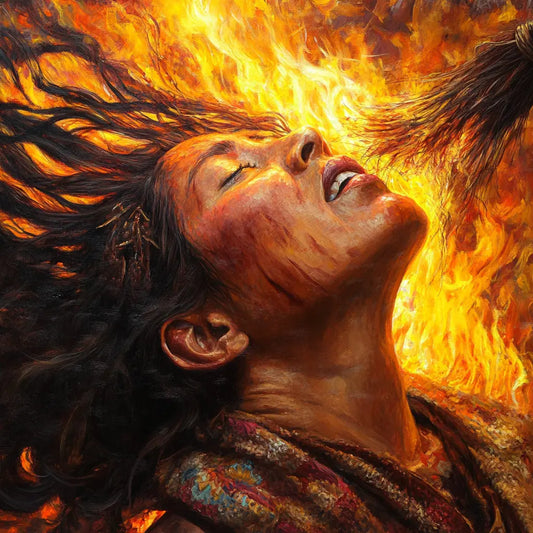Hair may seem like a simple part of the body, but it has long been the subject of curiosity and fascination. It's more than just a part of our appearance - hair has cultural, spiritual and even supernatural significance. From unexplained hair growth after death to medical conditions that cause excess hair or sudden hair loss, hair phenomena have baffled scientists and ordinary people alike throughout history. In this article, we'll explore historical oddities, medical mysteries and unusual hair fashion trends, revealing unexpected figures, cultural examples and interesting facts that are sure to interest you.

An introduction to hair oddities in history
Throughout the ages, hair has been a symbol of power, beauty, and identity, but it has also been associated with mystery. Historical sources abound with stories of unexplained phenomena involving hair: rapid growth, hair loss due to curses, and even sudden changes in hair color. For example, some ancient cultures believed that hair loss was a sign of divine punishment or evil spirits.
- Did you know? On average, people have between 100,000 and 150,000 hairs on their heads, and each one grows about 0.35 mm per day . However, there are cases throughout history where people have reported that their hair grew several centimeters overnight, leaving more questions than answers.
Let's delve into these strange stories, as well as pay attention to the scientific and cultural contexts that explain why hair has always been such a powerful symbol in various societies.
Strange hair phenomena in historical sources
Hair has been at the center of many unexplained phenomena throughout history. From mysterious growth after death to hair changes during stress, these stories have fascinated people for centuries.
Unexplained hair growth after death
One of the most ingrained myths is that hair grows after death. This belief dates back to ancient times and is recorded in various cultures. For example, some early Christian texts describe how the hair of saints continued to grow after their death, and their followers considered these relics sacred.
- Cultural Insight: In medieval Europe, it was common to exhume saints years after their burial and find their bodies miraculously preserved, with hair and nails seemingly growing back. These relics were often displayed in churches to strengthen faith.

The scientific explanation is much simpler. After death, the body dehydrates, the skin shrinks, and it gives the impression that hair and nails have grown longer. However, this is just an illusion caused by tissue shrinkage.
- Fun fact: In ancient Egypt , mummies were found with hair that looked “new.” However, this was due to mummification techniques that caused the skin around the scalp to tighten, making the hair appear longer.
Rapid hair growth during trauma
Historical sources contain accounts of people whose hair supposedly grew rapidly due to trauma or severe stress. For example, some medieval soldiers claimed that their hair grew several centimeters overnight after surviving a battle. While such reports may seem incredible, stress does indeed affect hair growth cycles, although not in such a drastic way.

- Scientific insight: Hair grows in cycles, and most hair follicles are in the resting phase at any given time. However, severe physical or emotional stress can stimulate more follicles to enter the growth phase, sometimes resulting in faster hair growth.
- Rare fact: Telogen effluvium , a condition in which stress causes sudden hair loss, has been described in medical sources since 1929 , proving that hair and stress have always had a close connection.
Sudden hair loss and its historical explanations
In many cultures, unexplained hair loss was often seen as a sign of divine punishment or witchcraft. In ancient Greece , soldiers who returned from war bald were believed to have angered the gods. In the Middle Ages, mysterious hair loss was sometimes attributed to curses or spells cast by enemies.
- A surprising number: Alopecia areata , an autoimmune condition that causes sudden, circular patches of hair loss, affects about 2% of the world's population . It has been recognized for thousands of years, with the earliest descriptions found in Egyptian medical texts dating back to 1550 BC .

In some cases, historical accounts of sudden hair loss may have been linked to high stress levels, poor nutrition, or infections—conditions that were not well understood in the past.
Medical secrets related to hair
Some of the strangest hair phenomena come from the world of medicine. While we understand a lot about how hair works, there are still conditions that baffle scientists and have no easy explanations.
Hypertrichosis: "Werewolf Syndrome"
Hypertrichosis , also known as "werewolf syndrome," is a rare condition that causes excessive hair growth all over the body, including the face. There are only about 50 known cases recorded since the Middle Ages. One of the most famous cases was Petrus Gonsalvus , born in 1537 in the Canary Islands, whose entire body was covered in thick hair.
- Surprising number: Hypertrichosis can cause hair growth of up to 5 cm on the face and body, with some sufferers having ten times more hair follicles in certain areas of the body than normal.

This rare genetic disorder has fascinated both medical experts and the public for centuries. In the 19th and 20th centuries, people with hypertrichosis were often displayed in circuses or fairs as "natural oddities," thus perpetuating the werewolf myth.
Can stress really turn your hair gray overnight?
One of the most common hair myths is that severe stress can turn hair gray or white overnight. This belief has existed for centuries, with famous cases like Marie Antoinette , whose hair is said to have turned white before her execution, and Thomas More , who experienced the same thing before his was cut off.

- Medical fact: While it's not possible for your hair to suddenly change color, stress can speed up the graying process. A condition called canities subita can cause rapid loss of hair pigment, but it usually happens over weeks or months, not overnight.
- Surprising study: A 2020 Columbia University study found that stress can cause reversible graying by depleting the stem cells responsible for pigment in hair follicles. This suggests that in some cases, hair can regain its original color if stress is reduced.
Alopecia areata: the mysterious cause of hair loss
Alopecia areata is an autoimmune disease that causes sudden hair loss, usually in patches. It affects an estimated 6.8 million people in the United States alone. The exact cause is still unknown, although it is believed to be caused by genetic and environmental factors.
- Fun fact: Alopecia universalis , an extreme form of this condition, causes the loss of all body hair, including eyebrows and eyelashes.

What makes alopecia areata particularly mysterious is its unpredictability. Some people experience hair regrowth after a few months, while others may experience long-term or permanent hair loss.
Weird hair trends through the ages
Throughout history, people have used their hair as a form of self-expression, status, and even rebellion. Some of the strangest hair trends were so unusual that they still fascinate us today.
18th Century Wigs: Elite Status Symbols
In 18th century Europe, wigs became a symbol of power and prestige. These tall, powdered wigs could reach impressive heights, some exceeding 30 inches . The larger and more elaborate the wig, the higher the social status.

- Fun fact: Wigs were so heavy and intricate that people often had to use wooden stands or have wig-tying services put on them throughout the day. A typical wig could weigh around 3-4 kilograms , and some even had hidden compartments to store small items.
Wigs weren't just a fashion statement. They also helped hide the effects of diseases like syphilis, which caused hair loss, and were used to prevent lice.
Royal hairstyles: a sign of power or eccentricity?
Some of the most powerful monarchs in history had truly unique hairstyles that reflected their personalities or political power. For example, Queen Elizabeth I of England was known for her iconic red hairdo, which she wore intricately. She even wore wigs to maintain an image of eternal youth.

- Historical insight: In some ancient Chinese dynasties, long hair symbolized vitality and wisdom. It was common for emperors to grow their hair to enormous lengths, with some reaching over 6 feet in length.
The eccentric hairstyles of royalty often reflected more than just personal taste – they were a symbol of power, status, and, sometimes, eccentricity.
Myth debunking or interesting facts
- Myth: Hair continues to grow after death.
Fact: This is just an illusion caused by skin shrinkage when the body becomes dehydrated. - Fun fact: The longest hair on record belongs to Xie Qiuping from China, whose hair was 18 feet and 5.54 inches long in 2004.
- Myth: Stress can turn your hair gray overnight.
Fact: Stress can speed up graying, but it doesn't happen instantly. The process takes weeks or months. - Fun fact: Queen Marie Antoinette's famous "overnight whitening" of her hair is probably a myth. The actual graying process would have taken much longer.
- Myth: Frequent hair cuts promote hair growth.
Fact: Hair growth is determined by genetics and hormones, not how often it is cut. Regular haircuts can help prevent split ends, making your hair look healthier.

Practical tips
- Manage stress for healthier hair: Stress can affect hair health. Yoga, meditation, or simply relaxation practices can help.
- Take care of your scalp: A healthy scalp promotes hair growth. Clean and moisturize your scalp regularly to reduce hair loss and breakage.
- Choose nutritious foods: Foods rich in biotin, zinc, and iron can support healthy hair growth. Consider adding more leafy greens, nuts, and lean proteins to your diet.
- Avoid harsh hair treatments: Limit the use of heat styling products and chemical treatments. These can weaken hair and cause it to break over time.
- Consult a doctor about hair loss: If you notice sudden or severe hair loss, consult a healthcare professional. Early diagnosis can help manage conditions like alopecia.

Frequently asked questions
- Can stress cause hair loss?
Yes, stress can cause a condition called telogen effluvium , which causes temporary hair loss. - What causes sudden hair color changes?
Sudden changes in hair color are rare and usually related to medical conditions such as sudden graying or pigment disorders. - Is there a cure for alopecia?
There is no cure, but treatments such as corticosteroids and topical therapies can help control hair loss. - How fast does hair grow on average?
Hair grows about 0.35 mm per day , or about half an inch per month . - Can gray hair caused by stress be reversed?
In some cases, stress-induced hair color changes can be reversed, but this depends on individual health factors.

Conclusion
Hair has long been a source of fascination, and as we've seen, it's often associated with beauty and mystery. From historical oddities to modern medical mysteries, hair phenomena continue to fascinate. Whether you're dealing with hair health issues, curious about strange historical hair events, or simply want to learn more about the science of hair growth, there's always something new to learn. Embrace your unique hair journey knowing that behind every strand lies a story, full of history, science, and mystery.













